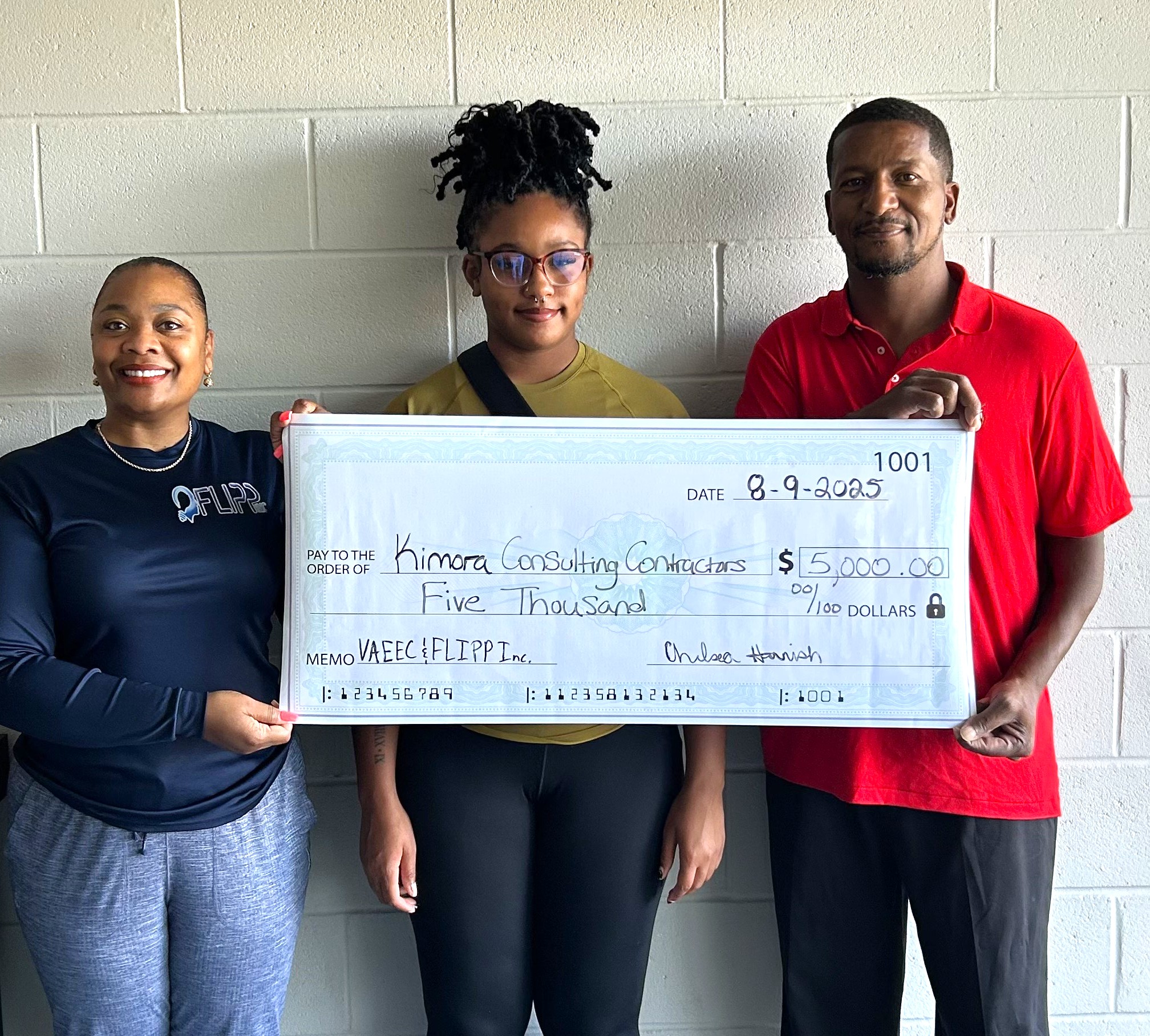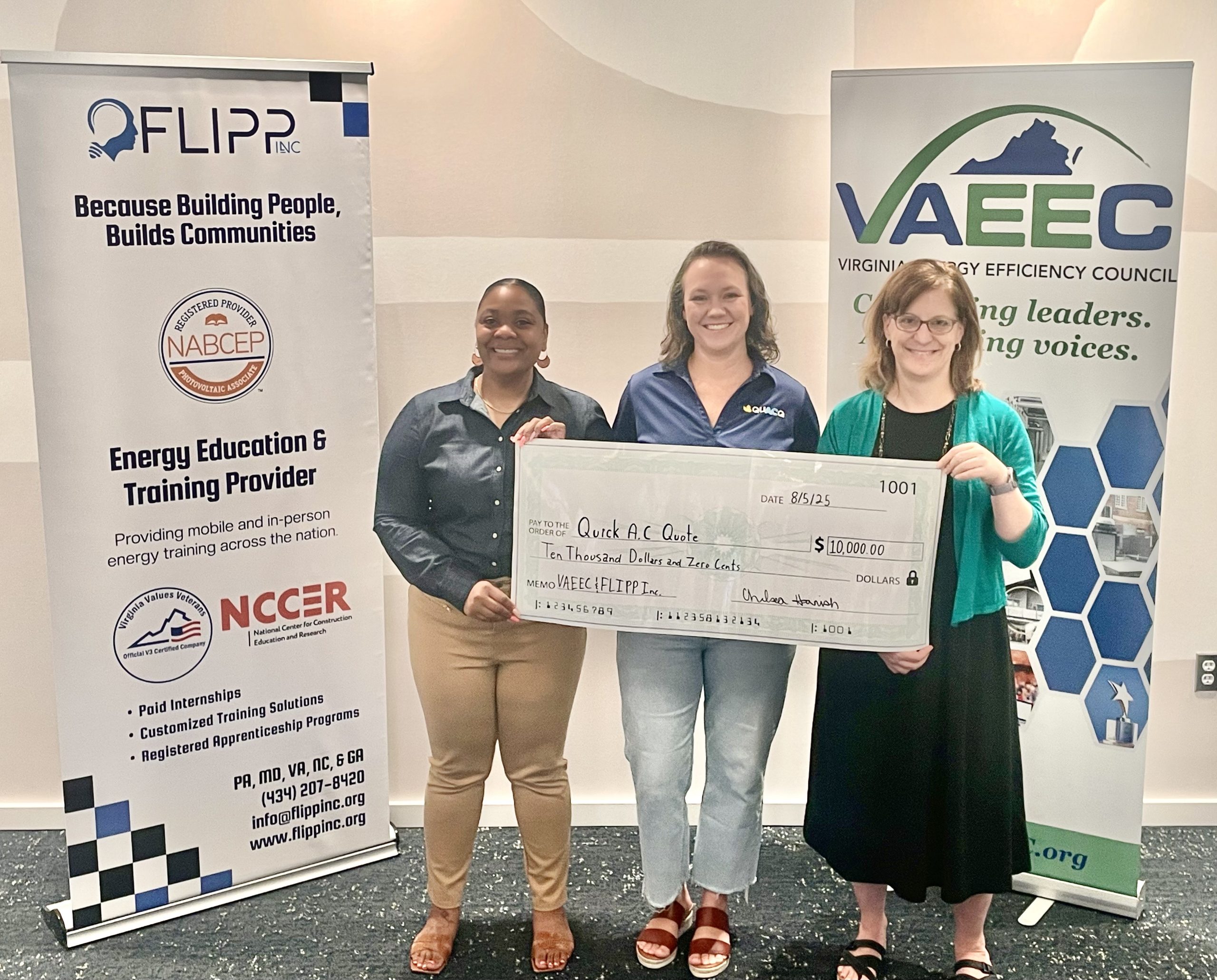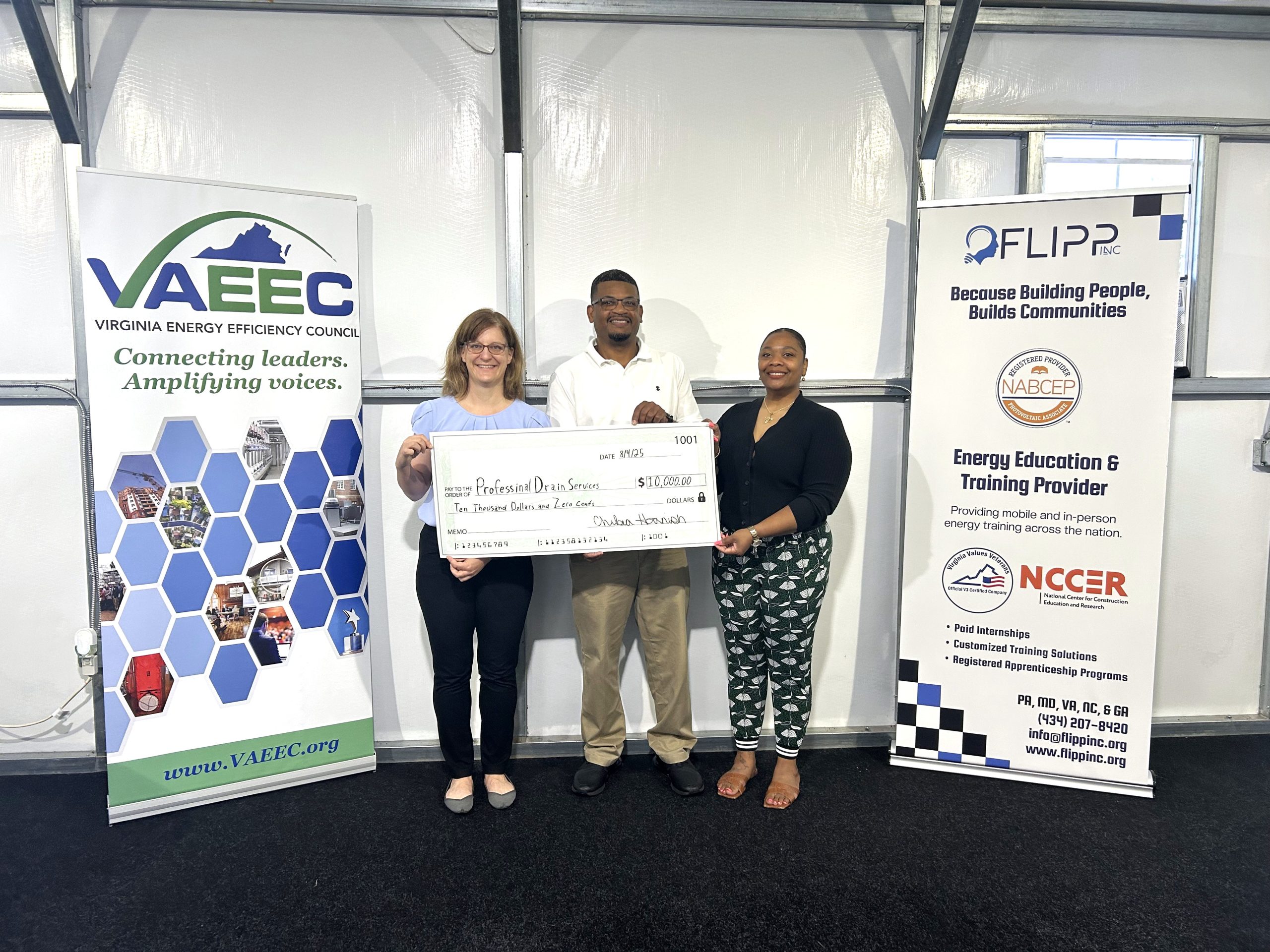The Commonwealth’s energy efficiency community gathered on October 15th and 16th for the VAEEC’s 2025 Energy Efficiency Forum. Almost 130 people attended across two days to learn, network, and celebrate industry achievements. Thank you to our sponsors, speakers, award winners, and attendees for making this event a great success!
Day one was fully virtual in an effort to make the event more accessible and to provide a diverse array of speakers. It consisted of a keynote address and four breakout sessions:
Keynote Address: Dr. Reuven Sussman, Director of the Behavior, Health and Human Dimensions Program at ACEEE spoke about changing consumer behaviors through the EAST framework – making the change Easy, Attractive, Social, and Timely. He also walked through case studies for successful behavioral energy efficiency programs.
As in previous years, we held concurrent breakout sessions.
Energy Efficiency Messaging that Works: This panel focused on how to translate technical jargon into actionable messaging around EE. One of the panelists likened building a story to building a house and encouraged participants to explain EE “like you’re talking to your grandma.” The panelists were Charles Paullin (InsideClimateNews), Jake Barnet (ClearlyEnergy), Rad Tollet (Rad Tollet LLC), and was moderated by VAEEC Board Secretary Bill Eger (ETHOS Sustainability).
EE on Campus – Innovation Across Virginia’s Colleges: Universities are a unique proving ground for energy efficiency and clean energy advancements. This discussion focused on projects and programs across three top Virginia schools, and how they can act as a proof of concept for their surrounding communities. The panelists were Jesse Warren (University of Virginia), Greg Farley (George Mason University), Nam Nguyen, and was moderated by VAEEC Board member McKenna Dunbar (The Grid Foundry).
Tracking Incentives for Energy Improvements: Utility programs, appliance rebates, tax credits, weatherization – navigating the maze of EE incentives in an ever-changing world is difficult even for professionals. This panel looked at federal, state, and local tools to help homeowners, renters, business owners, and contractors take advantage of these programs. The panelists were Noah Goldmann (Rewiring America), Jessica Greene (Virginia Energy), Maya Dhavale (Fairfax County), and was moderated by Rebecca Hui (VAEEC).
Utility Led EE in Rural Virginia: How Co-ops and Providers are Getting it Done. Tackling energy efficiency in rural Virginia can be a challenge, but the coops and local agencies in these areas have a keen sense in how to overcome those challenges. Erin Puryear, Old Dominion Electric Cooperative discussed the importance of educating coop members while Kris Sieber Dunn with Rappahannock Electric Cooperative presented on the various tools that REC has at its disposal to help members. Aubrey Myers with the Pittsylvania County Community Action Agency rounded out the panel with a focus on weatherization. The panel was moderated by Elena Vera with ICF.
Attendees gathered in person for day two at the University of Richmond Jepson Alumni Center in Richmond. The day began with an opening presentation from Executive Director, Chelsea Harnish. Attendees were provided with updates and a brief overview of the Commonwealth’s energy efficiency industry, as well as our new, three-year Strategic Plan.
The day also included a keynote address, a plenary panel, the tenth annual Virginia Energy Efficiency Leadership Awards ceremony, and an on-site reception.
Keynote Address: We were honored to have SCC Commissioner, Judge Kelsey Bagot, as our keynote speaker for the in-person event. Judge Bagot talked about the important role energy efficiency plays in keeping energy affordable and managing the load from data centers. She also addressed the “meaningful change [that] can happen outside of the legislative process” by the “boots on the ground,” such as VAEEC members. Finally, Judge Bagot left us with a call to action to help the SCC bring creative, new solutions online by providing the data the Commissioners need to evaluate energy efficiency and demand response programs.
Using Data to Drive Energy Efficiency Campaigns: Good data is behind every successful energy efficiency initiative, but gathering, assessing, and messaging can be tricky. This panel discussed how to distill technical data into usable information, turn facts into storytelling, and emphasized the importance of “starting with the end in mind”. The panelists were Emma Kirby (Potential Energy Coalition), Jacqui Bauer (Community Climate Collaborative), Sapna Gheewala Dowla (Alliance to Save Energy), and was moderated by Katie VanLangen (Local Energy Alliance Program).
Energizing Efficiency Campaign & Virginia Energy Efficiency Leadership Awards Ceremony: Next, we had the honor of hosting our tenth Virginia Energy Efficiency Leadership Awards ceremony. Since 2016, we have recognized dozens of outstanding projects and programs across the Commonwealth, from low-income weatherization on Tangier Island to HVAC upgrades at Monticello to the lighting and heating improvements at the Virginia Beach aquarium.
This year, we started off by highlighting the submissions to our Energizing Efficiency Campaign. From these submissions, two were chosen by the VAEEC’s Education & Events Committee to receive a 2025 Virginia Energy Efficiency Leadership Award for their incredible energy efficiency contributions. For information on each winning project or program, visit our 2025 Awards page.
The event concluded with an on-site networking reception. It is always a pleasure to connect with many of our members and others in the industry face-to-face, and this was no exception.
Thank you to our sponsors, speakers, award winners, and event attendees for making this one of our best events to date. View photos of the event below. Additional event information, including speaker biographies and sponsor features, can be found in the event program.
There are over 300 data centers in Virginia right now, with 241 of them concentrated in Northern VA, and new centers are proposed or approved every day. Loudoun County alone has 117 in the pipeline. It’s little wonder why – the Commonwealth boasts over $9 billion in tax revenue from the data center industry alone. As an economic driver, that is completely unmatched. Legislators and other decision-makers rely on that income for local and statewide endeavors.
As an environmental and energy factor? Not so good. IEA forecasts that energy demand will double by 2030. “In the United States, power consumption by data centers is on course to account for almost half of the growth in electricity demand between now and 2030. Driven by AI use, the US economy is set to consume more electricity in 2030 for processing data than for manufacturing all energy-intensive goods combined, including aluminum, steel, cement and chemicals.”
What does that mean for Virginia, though? Data centers have been hailed as economic drivers, scorned for being environmentally damaging, and feared for their effects on the electric grid. The General Assembly has been slow to move on legislation to regulate the industry, leaving it open to runaway growth.
What is a data center?
Great question. The International Energy Conservation Code defines a data center as, “a room or series of rooms that share data center systems (later defined as HVAC systems and equipment used to provide cooling or ventilation), whose primary function is to house equipment for the processing and storage of data and that has a design total information technology equipment (ITE) equipment density exceeding 20 watts per square foot of conditioned area and a total design ITE equipment load greater than 10 kW.”
The Code of Virginia defines a data center as, “a facility whose primary services are the storage, management, and processing of digital data and is used to house (i) computer and network systems, including associated components such as servers, network equipment and appliances, telecommunications, and data storage systems; (ii) systems for monitoring and managing infrastructure performance; (iii) equipment used for the transformation, transmission, distribution, or management of at least one megawatt of capacity of electrical power and cooling, including substations, uninterruptible power supply systems, all electrical plant equipment, and associated air handlers; (iv) Internet-related equipment and services; (v) data communications connections; (vi) environmental controls; (vii) fire protection systems; and (viii) security systems and services.”
And the American Council for an Energy Efficiency Economy (ACEEE) states, “data center is a general term that can refer to a range of facilities housing computer servers and networking equipment with very different power and market characteristics.”
The lack of clarity on what a data center is, makes regulating and legislating the industry incredibly difficult. Moreover, as ACEEE notes, there is no one-size-fits-all definition for the different types of data centers. The server room for the City of Richmond operates very differently than the enterprise scale center for Bank of America, which is itself different from a company like Amazon or Microsoft.
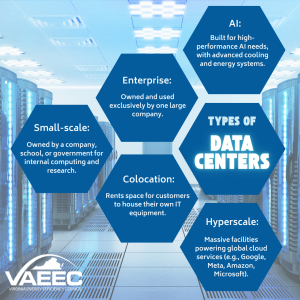
AI and Energy
The AI industry, and by extension crypto, relies on computing equipment that uses exponentially more energy and water than a traditional data center. Vox recently reported that a typical Google search uses .3 watt-hours, while ChatGPT uses over nine times as much energy at 2.9 watt-hours. And while there are strides being made to improve chip efficiency and cooling efficiency, the risk of downtime keeps many of these technologies from widespread use.
There are additional uncertainties tied also to speed of adoption, ongoing legislative and legal battles, and effects on the economy. However, all of the projections and models are based on currently available technologies, which are changing rapidly. AI companies are in a period of explosive growth, but that is not sustainable long term. As technology moves from experimentation to market saturation, standardization will ultimately lower the energy spikes we see now.
There’s also the DeepSeek curveball to consider – by using older models of Graphic Processing Units (GPUs) and an optimized algorithm, the Chinese company released R1, a rival to ChatGPT and other commercial AI products, that uses as little as 10% of the electricity for the same output. This also reduced the cost of operations for DeepSeek, while providing a proof of concept to the industry.
And while AI technology is causing a number of environmental problems – air pollution, overconsumption of electricity, water pollution – it also has the potential to solve some problems, also. A recent article from the Federation of American Scientists said, “Leaders have a real opportunity to leverage AI to maximize positive outcomes—like improving grid efficiency, accelerating clean energy deployment, and optimizing public services—while minimizing harms like overconsumption of energy and water, or reinforcing environmental injustice. Doing so, however, will require new economic and political incentives that align private investment with public benefit.”
Solutions
AI, hyperscale, and cloud computing data centers are heavily incentivized to run as efficiently as possible, as a huge percentage of their overhead costs are from electricity and water use. But as the strain on the grid due to AI increases, some companies are building their own generation systems. Some of these are focused on renewable energy while others rely on fossil fuel generation for energy.
Solutions like demand response, timed cooling, virtual power plants, and other energy efficiency measures can reduce the load without additional generation.
Companies like VAEEC members Siemens, Schneider Electric, and Michael’s Energy have been working with companies for years on cooling, insulation, and automation systems that reduce the up-front load. As up to half of the energy use in a large scale data center is accounted for just by cooling, timed fans, in rack cooling structures, and district heating are just a few of the proven, existing solutions that are available for companies and operators. Utilities and coops are also looking at rate structures and incentives to shift the load on the grid.
The energy efficiency opportunities for data centers can make a significant difference in the amount of energy used in operations. ACEEE released a series of recommendations for states to incentivize data center companies to adopt transparent, energy efficient, and grid interactive practices. Similarly, ASHRAE and Energy STAR have guidelines and standards for more efficient facilities. Though without policy and financial incentives, companies are unlikely to adopt these standards.
Modeling and Projection
According to some estimates, Loudoun’s projected load demand from new data centers could draw 8,190 MW from the grid, on top of the collective 3 GW demand from data centers at large. The potential demand for electricity is daunting, but recent studies may calm the alarm.
As stated above, models and projections on data center energy use are based on currently available technologies in an industry rapidly changing from day to day. The National Labs state that they can confidently project load through 2028 – just two years from now. Factors like electrification, EV adoption, international and economic uncertainty, and an unfettered market make it nearly impossible to predict long-term needs.
Moreover, only a fraction of proposed data centers actually make it into production. Companies regularly buy spots on the interconnection queue for projects that are still in the planning process and may not see approval from the locality or land owner. While utilities and regulatory bodies are starting to account for these proposals, the conversations are still in early stages on how to standardise and streamline processes so that clearer projections can be made.
The Bottom Line
The data center industry is a huge economic driver in Virginia and is here to stay. By utilizing efficient building techniques, investing in energy efficient technologies, and adopting distributed energy resources, companies can manage their load responsibly and project future needs more accurately.
ORGANIZATIONS AWARDED GRANTS TO BUILD VIRGINIA’S ENERGY EFFICIENCY WORKFORCE
VAEEC and FLIPP Inc. honor recipients of the Energy Efficiency Workforce Initiative
Hampton Roads, Virginia — August 9th, 2025. The Virginia Energy Efficiency Council (VAEEC) and FLIPP Inc. are celebrating the first round of awards to local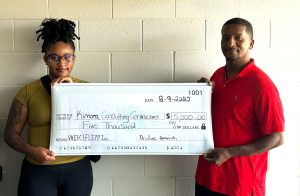 contractors as part of the Energy Efficiency Trades Workforce Development Program, born out of VAEEC’s Energy Efficiency Workforce Initiative (EEWI). The program leverages VAEEC’s statewide network and FLIPP Inc.’s on-the-ground community engagement to support workforce development. Together, we are bridging gaps and building capacity for a stronger, more inclusive energy efficiency workforce across Virginia.
contractors as part of the Energy Efficiency Trades Workforce Development Program, born out of VAEEC’s Energy Efficiency Workforce Initiative (EEWI). The program leverages VAEEC’s statewide network and FLIPP Inc.’s on-the-ground community engagement to support workforce development. Together, we are bridging gaps and building capacity for a stronger, more inclusive energy efficiency workforce across Virginia.
The event is part of a press tour across the Commonwealth celebrating the first cohort of awardees. These grants support training, education, and job placement efforts for careers in energy efficiency, an industry critical to achieving climate goals and building economic resilience.
“They say no one wants to work in the trades, but it’s not that. It’s that we don’t have the opportunities or the proper training to get into the field,” said Mr. Terrell Davis, CEO of Kimora Consulting Contractors.
“We are proud to partner with FLIPP Inc. on this innovative, statewide initiative,” said Chelsea Harnish, Executive Director of the VAEEC. “By supporting energy efficiency contractors and trades across Virginia, we are advancing workforce development, promoting equity, and driving a sustainable energy future.”
“Diversifying while simultaneously advancing the skilled trade industries fosters innovation, enhances problem-solving and enables businesses like Kimora Consulting Contractors to adapt to changing needs and challenges – especially within the Hampton Roads Region”, said Raye Elliott, Co-Founder & Executive Director, FLIPP Inc.
**************************************************************************************
About VAEEC:
Founded in 2012, VAEEC is a 501(c)(3) organization headquartered in Richmond, whose goal is to facilitate discussions and share resources to advance energy efficiency throughout the Commonwealth. We engage our members to identify barriers to and opportunities for energy efficiency advancement, and to develop a strong, fact-based, and balanced industry voice before local, state, and national policymakers and regulators. Our diverse group of over 100 members includes Fortune 500 companies, nonprofits, local governments, state agencies, and more, whose vision is for energy efficiency to be an integral part of Virginia’s economy and clean energy future.
About FLIPP Inc.:
FLIPP Inc. is a Black-, female-, veteran-, and justice-impacted-led, NABCEP-accredited 501(c)(3) organization whose mission is to create an inclusive workforce that reduces employment barriers for justice-impacted individuals, veterans, BIPOC, women, and youth, and empowers low-income communities with renewable energy and entrepreneurship development training.
FOR IMMEDIATE RELEASE
Date: AUGUST 5TH, 2025
ORGANIZATIONS AWARDED GRANTS TO BUILD VIRGINIA’S ENERGY EFFICIENCY WORKFORCE
VAEEC and FLIPP Inc. honor recipients of the Energy Efficiency Workforce Initiative
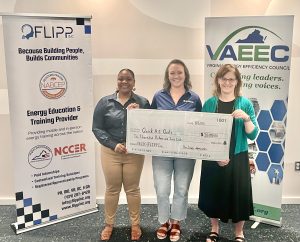 Glen Allen, Virginia — August 5th, 2025. Today, the Virginia Energy Efficiency Council (VAEEC) and FLIPP Inc. are celebrating the first round of awards to local contractors as part of the Energy Efficiency Trades Workforce Development Program born out of VAEEC’s Energy Efficiency Workforce Initiative (EEWI). The program leverages VAEEC’s statewide network and FLIPP Inc.’s on-the-ground community engagement to support workforce development. Together, we are bridging gaps and building capacity for a stronger, more inclusive energy efficiency workforce across Virginia.
Glen Allen, Virginia — August 5th, 2025. Today, the Virginia Energy Efficiency Council (VAEEC) and FLIPP Inc. are celebrating the first round of awards to local contractors as part of the Energy Efficiency Trades Workforce Development Program born out of VAEEC’s Energy Efficiency Workforce Initiative (EEWI). The program leverages VAEEC’s statewide network and FLIPP Inc.’s on-the-ground community engagement to support workforce development. Together, we are bridging gaps and building capacity for a stronger, more inclusive energy efficiency workforce across Virginia.
The event is part of a press tour across the Commonwealth celebrating the first cohort of awardees. These grants support training, education, and job placement efforts for careers in energy efficiency, an industry critical to achieving climate goals and building economic resilience.
“This funding will be instrumental in assisting with the costs of training the workforce of the future. The organization is grateful to FLIPP inc. and the VAEEC for the investment in the community’s workforce. The grant expands the organization’s reach and equips individuals with valuable lifetime skills for the current job market, while strengthening the local economies across two states” said a Quick A.C Quote representative.
“We are proud to partner with FLIPP Inc. on this innovative, statewide initiative,” said Chelsea Harnish, Executive Director of the VAEEC. “By supporting energy efficiency contractors and trades across Virginia, we are advancing workforce development, promoting equity, and driving a sustainable energy future.”
“Innovative and novel programs like the Trades Workforce Development Program funded by the EEWI represent a down payment on accelerating workforce development within the skilled trades across the State of Virginia and addressing funding gaps that are affecting that innovation and deployment. This award to Quick AC Quote demonstrates our collective commitment to encouraging employment of women in Registered Apprenticeship, OJT and non-traditional occupations and the delivery of supportive services, as well as employer incentives.,” said Raye Elliott, FLIPP Inc. Co-Founder and Executive Director.
**************************************************************************************
About VAEEC:
Founded in 2012, VAEEC is a 501(c)(3) organization headquartered in Richmond, whose goal is to facilitate discussions and share resources to advance energy efficiency throughout the Commonwealth. We engage our members to identify barriers to and opportunities for energy efficiency advancement, and to develop a strong, fact-based, and balanced industry voice before local, state, and national policymakers and regulators. Our diverse group of over 100 members includes Fortune 500 companies, nonprofits, local governments, state agencies, and more, whose vision is for energy efficiency to be an integral part of Virginia’s economy and clean energy future.
About FLIPP Inc.:
FLIPP Inc. is a Black-, female-, veteran-, and justice-impacted-led, NABCEP-accredited 501(c)(3) organization whose mission is to create an inclusive workforce that reduces employment barriers for justice-impacted individuals, veterans, BIPOC, women, and youth, and empowers low-income communities with renewable energy and entrepreneurship development training.
VAEEC and FLIPP Inc. honor recipients of the Energy Efficiency Workforce Initiative
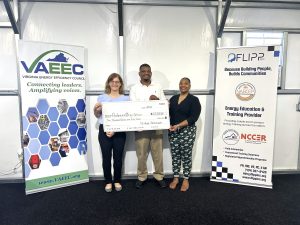
Dillwyn, Virginia — August 4th, 2025. Today, the Virginia Energy Efficiency Council (VAEEC) and FLIPP Inc. are celebrating the first round of awards to local contractors as part of the Energy Efficiency Trades Workforce Development Program born out of VAEEC’s Energy Efficiency Workforce Initiative (EEWI). The program leverages VAEEC’s statewide network and FLIPP Inc.’s on-the-ground community engagement to support workforce development. Together, we are bridging gaps and building capacity for a stronger, more inclusive energy efficiency workforce across Virginia.
The event is part of a press tour across the Commonwealth celebrating the first cohort of awardees. These grants support training, education, and job placement efforts for careers in energy efficiency, an industry critical to achieving climate goals and building economic resilience.
“This grant is definitely appreciated and will help me expand business opportunities in our community in South Central, Virginia,” said Terrence Johnson, Owner of Professional Drain Service.
“We are proud to partner with FLIPP Inc. on this innovative, statewide initiative,” said Chelsea Harnish, Executive Director of the VAEEC. “By supporting energy efficiency contractors and trades across Virginia, we are advancing workforce development, promoting equity, and driving a sustainable energy future.”
“The Skilled Trades Workforce Program is making a difference for individuals entering and skilling up in the trades. At the same time, the program benefits employers by supporting them to provide on-the-job training, registered apprenticeships, and business development. By investing in skilled trades employers, we’re creating career pathways for skilled tradesmen and advancing energy efficiency across the Commonwealth,” said Emily Axelbaum, FLIPP Inc. Project Coordinator.
**************************************************************************************
About VAEEC:
Founded in 2012, VAEEC is a 501(c)(3) organization headquartered in Richmond, whose goal is to facilitate discussions and share resources to advance energy efficiency throughout the Commonwealth. We engage our members to identify barriers to and opportunities for energy efficiency advancement, and to develop a strong, fact-based, and balanced industry voice before local, state, and national policymakers and regulators. Our diverse group of over 100 members includes Fortune 500 companies, nonprofits, local governments, state agencies, and more, whose vision is for energy efficiency to be an integral part of Virginia’s economy and clean energy future.
About FLIPP Inc.:
FLIPP Inc. is a Black-, female-, veteran-, and justice-impacted-led, NABCEP-accredited 501(c)(3) organization whose mission is to create an inclusive workforce that reduces employment barriers for justice-impacted individuals, veterans, BIPOC, women, and youth, and empowers low-income communities with renewable energy and entrepreneurship development training.
The Trump administration’s megabill will have sweeping consequences across many sectors, including energy efficiency. Recent analysis from Energy Innovation shows that the bill “as passed would increase annual energy bills by $20 billion across all American households annually in 2030, swelling to more than $37 billion in higher energy costs by 2035, for a total of $170 billion during the budget window of 2025 to 2034.” Further data from the National Economic Research Associates shows an 8.3% increase in Virginia electricity bills by 2029 from the loss of tax credits alone.
As enacted, the megabill sunsets a number of energy efficiency tax credits that were introduced in the 1970s and significantly expanded under the Inflation Reduction Act (IRA). The tax credits sunset on different dates as outlined below:
- Residential Energy Efficiency Tax Credit (25C)- December 31, 2025
- New Home Construction (45L) tax credit- June 30, 2026
- Energy Efficient Commercial Buildings (179D) tax credit- June 30, 2026
Since the passage of the IRA, these tax credits have driven millions of dollars of investment in Virginia and save homeowners an average of $130 per year on energy bills.
Additional provisions of the megabill:
- Rescinds all unobligated funds for the State-Based Training Residential Energy Efficiency Contractor (TREC) program. Virginia TREC funds were not obligated prior to passage of the megabill, therefore the commonwealth will miss out on receiving $3.4M in dedicated funds to expand the energy efficiency workforce.
- Repeals the Greenhouse Gas Reduction Fund (GGRF), including the National Clean Investment Fund (NCIF), the Clean Communities Investment Accelerator (CCIA), and Solar for All. According to other advocacy groups, this could lead – or even require – EPA to terminate existing contracts. Virginia has already received funding for Solar for All, so it is uncertain how that program will proceed.
- Rescinds all unobligated funds for the Climate Pollution Reduction Grant (CPRG) program. While state CPRG funds have been received, local and Metropolitan Statistical Area (MSA) projects may be affected.
- Rescinds unobligated funds for the Green and Resilient Retrofit Program (GRRP), which funds critical upgrades in low-income housing on two projects in Virginia, along with others across the country. It is unclear if the GRRP projects in Hampton Roads have been completed and, as such, would be affected by this bill.
- Foreign Entity of Concern (FEOC) provisions will limit the use of credits on projects or companies with ties to certain nations, including China. The requirements for this provision are extremely unclear and need further definition by the Treasury and IRS. However, as written, these provisions could cause prices on goods and materials to skyrocket as well as extreme delays in production. FEOC restrictions will take effect on projects started after January 1, 2026
While these developments will affect some sectors of the energy efficiency industry in Virginia, the following programs are not touched by the megabill at all:
- Home Energy Rebate Program funds
- Energy Efficiency Conservation Block Grants (EECBG)
- Renew America’s Schools, though the effects of the FEOC may present challenges to these projects.
Update as of 7/9: DOE announced their plan to release $400M in Weatherization Assistance Program funds. These funds are allocated on an annual, formula basis but had not been disbursed to some grantees earlier in the year. While there is no timeline on when providers will receive the money, this announcement is a step in the right direction. However, to align with the President’s earlier Executive Orders, an additional memo removes requirements that WAP energy audits include non-energy impacts regarding the social cost of carbon. This is a provision the provider networks had been pushing for years as it allows for additional improvements to the health and safety of the home.
Regarding the future of Energy STAR, the program is in a better position than initially thought. The Energy STAR program is statutorily required to exist, therefore the likelihood that it will be eliminated is low. The most likely scenarios at this time are for EPA to implement a fee-for-service model, transfer the program to DOE with budget and staff, or privatize the program. Energy STAR is still operating as usual and will continue to do so unless directed otherwise.
Despite the challenges, the fight is not over. VAEEC Member, the Alliance to Save Energy predicts that there will be another tax package presented to Congress later this year, which will present another opportunity to advocate for the energy efficiency tax credits and other programs. We will continue to provide updates as information becomes available.
In the first two posts of this series, we looked at the foundation of energy efficiency messaging and how to tailor that message to different audiences. But even the most compelling story or value proposition can fall flat if it’s delivered at the wrong time. Timing isn’t just about when your message goes out; it’s about when your audience is most ready to hear it.
Energy efficiency often becomes top-of-mind when people are reacting to a problem, a spike in their utility bill, an aging HVAC system, or a sweltering heatwave. These are the moments when messaging can feel most relevant and most likely to drive action.
“People search for energy efficiency opportunities in a reactive state of mind,” said Rad Tollet from Brand Federation. That means we need to be proactive. Anticipate seasonal pain points, like the start of summer or winter, and use those moments to promote energy-saving programs or resources before people feel the strain.
Use the Calendar to Your Advantage:
Planning around seasonal or situational triggers can help your message land:
- Spring and fall: Prime time to promote energy audits, insulation, and HVAC tune-ups.
- Tax season: Remind audiences about credits and rebates tied to energy efficiency upgrades.
- Move-in/back-to-school seasons: Reach renters and new homeowners with simple, low-cost solutions.
Align Timing with Platform
How you deliver the message matters just as much as when. Newsletters may resonate with homeowners. Text alerts or targeted social ads might better reach renters or younger audiences. And in historically underserved communities, trusted local partners, like non-profits, schools, or neighborhood leaders, may be your best messengers.
Repetition Builds Recognition
Don’t be afraid to repeat yourself, thoughtfully. People rarely act the first time they see a message. Use a mix of channels, voices, and formats to keep the message fresh while reinforcing your core point. Repetition builds recognition, and recognition builds trust.
As West Cary Group noted, effective campaigns plan for the full customer journey, not just a single impression. The key is showing up consistently and meaningfully, not just loudly.
Test, Learn, and Adjust
Timing isn’t a perfect science. Track when and how people are engaging with your messages, opens, clicks, participation rates, and feedback, and use those insights to improve. Over time, you’ll gain a clearer picture of what matters most to your audience and when.
Throughout this series, we’ve explored the foundations of energy efficiency messaging: how to make it relatable, how to tailor it for different audiences, and how to time it for the most impact. These strategies are more than just communication tips; they’re tools to help build trust, drive engagement, and ultimately, help more people benefit from energy efficiency.
We hope our Effective Communication, Efficient Energy blog series sparked ideas, offered useful insights, and gave you a strong foundation to build from, whether you’re launching a campaign, crafting an outreach plan, or simply looking for ways to connect with your community.
In last week’s post, we explored the importance of starting with the basics, what energy efficiency is, and why people should care. However, knowing what to say is only half the battle. If we want energy efficiency messaging to resonate, we have to consider who we’re speaking to. Different audiences have different needs, motivations, and frustrations, and our messaging needs to reflect that.
Be Curious:
Energy efficiency isn’t a one-size-fits-all concept. What resonates with a homeowner may not connect with a renter, small business owner, or contractor. That’s why understanding your audience is the key to making any message stick.
Communications professionals stress the importance of starting with simple, grounded questions:
“What behavior are we asking them to change, and what’s in it for them? Is it about cost savings, environmental impacts, comfort, control, or something else entirely?” said a representative from West Cary Group.
The answers to these questions can shift dramatically depending on the audience. Contractors and installers, for example, are on the front lines of bringing energy efficiency technologies into homes and businesses. Messaging for them should highlight opportunities for professional growth, available training, financial incentives, and how offering energy-efficient solutions can help them stand out in a competitive market. Meanwhile, low-income renters may feel they have limited control over their energy use. But with the right approach, messaging can make them aware of rebates, tax credits, or community programs that can directly lower their bills and improve comfort, at little or no cost. In both cases, tailoring the message to the audience’s unique circumstances makes engagement and action much more likely.
Once these foundational questions are answered, the next step is developing insights that shape the entire communication strategy.
West Cary Group recommends using a strategic brief that incorporates four core elements:
A deep human truth: What do people believe or feel about the topic, often beneath the surface?
Example: “I’m tired of being targeted and everything feels like a sales pitch, not something that’s actually for me.”
The tension: What’s the barrier or contradiction keeping them from acting?
Example: They distrust utility or government programs that promise benefits but feel like marketing spin.
A fresh idea: What’s a motivating angle that reframes the topic and opens the door for action?
Example: This isn’t a pitch, it’s an opportunity you already paid into.
The solution: What role does the campaign play in shifting perception or behavior?
Example: Frame energy efficiency programs as a benefit customers have earned and highlight real testimonials or neighbor-led stories to shift the tone from promotion to empowerment. At its core, effective messaging isn’t about convincing people; it’s about connecting with them. By starting with the audience’s lived experience, acknowledging their skepticism, and offering clear, personal benefits, energy efficiency becomes a real solution and less of a technical buzzword.
Next week, we’ll explore how timing and delivery can make or break a message. Even the best crafted message can fall flat if it arrives at the wrong moment. We’ll dive into how strategic timing and multi-channel delivery can help ensure your message lands when your audience is most ready to listen.
Why Energy Efficiency?
The Virginia Energy Efficiency Council lives and breathes energy efficiency; however, we recognise that it is a subject most people are not familiar with. Acknowledging this communication gap, the VAEEC is exploring how to best discuss and promote energy efficiency. To guide this work, we interviewed local public relations firms and communications professionals for our June blog series: Effective Communication, Efficient Energy. Each post will build upon the last, sharing key insights, guiding principles, and best practices for communicating a complex topic like energy efficiency to a broad audience.
The What and the Why
When introducing a topic most people aren’t already familiar with, it’s important to start with the basics: What is it, and why should your audience care? Energy efficiency advocates are passionate and informed, but the general public? Not always. SEO data backs this up; most people don’t seek out energy efficiency information until something happens to them, like a surprise high electric bill or the dreaded HVAC breakdown.
“People search for energy efficiency opportunities in a reactive state of mind,” said Rad Tollet from Brand Federation.
So, how do we take that knowledge and run with it?
Communication professionals recommend that we anticipate those pain points and promote energy efficiency programs, resources, and messaging right before peak moments, like the start of summer or winter, when bills often spike. Then we tailor the message to reflect what our audience cares about: saving money. If we want people to see the value of energy efficiency, we have to show it through real-life examples of how it impacts people just like them. Not in abstract numbers or policy jargon, but in stories that reflect their day-to-day realities and frustrations.
This kind of storytelling is strategy, and it’s the foundation of the most effective messaging in the energy world today.
That’s why effective energy efficiency messaging often starts with a simple premise: “This helps people just like you.” Instead of focusing on the technical benefits or environmental impact, though those matter too, we lead with how it can make a difference in someone’s daily life.
“We always start by reframing the message from the reader’s point of view, what would make this feel relevant or actionable?” said a representative from the West Cary Group.
Maybe it’s a single mom who cut her energy bill in half after a home weatherization project. Or a retiree who avoided a costly HVAC replacement thanks to a free energy audit. These kinds of stories show that energy efficiency isn’t just a policy buzzword; it’s a way to save money, reduce stress, and make homes more comfortable and resilient. When people see themselves reflected in the message, they’re more likely to trust it. They’re more likely to take action, and most importantly, they begin to understand that energy efficiency isn’t something abstract or out of reach; it’s a tool that can improve their quality of life, right now.
Several communication professionals recommended searching for and promoting success stories to demonstrate that energy efficiency programs can and will save you money. By highlighting the human impact, we can see how these programs help people save, shifting energy efficiency from an abstract concept to an everyday solution. The Virginia Energy Efficiency Council launched its Energizing Efficiency Campaign in 2023 to do exactly that. By uplifting success stories across the Commonwealth, we hope to enlighten our audience to the numerous benefits of energy efficiency. Applications are currently open and will close on August 4th, 2025. Click here to submit your success story!
But knowing what to say is only half the challenge. Next week, we’ll dive into who you’re speaking to and how to shape your message so it resonates. From renters and homeowners to business owners and community leaders, energy efficiency messaging is most effective when it meets people where they are.
The Virginia Energy Efficiency Council (VAEEC) recently hosted the Energizing Efficiency Webinar, an engaging and insightful event that celebrated past Energizing Campaign participants and their energy efficiency projects impacting Virginia, as well as the launch of VAEEC’s 2025 Energizing Efficiency Campaign. Held on Tuesday, February 19th, 2025, this webinar brought together three expert speakers and compelling projects. The event kicked off with an introduction to the VAEEC, and our work as a leading voice for energy efficiency since 2012.
Our first speaker was Jessica Greene, Virginia Energy’s Energy Outreach Coordinator. Jessica started with a history lesson on the Energizing Efficiency Campaign, which invites submissions from across the Commonwealth to highlight impactful energy-saving projects. This campaign provides a platform for all projects—big or small—to showcase their contributions to energy efficiency. She emphasized Virginia Energy’s intent to participate in the 2025 campaign and promoted the Energy Efficiency & Conservation Sub-Grants for local governments.
Samantha Hudson, Sustainability Division Director at Henrico County, detailed the impressive sustainability measures integrated into five of Henrico County’s Libraries, which achieved LEED Gold certification in 2021. Key features of the libraries include enhanced energy efficiency, reduced energy use by approximately 50% compared to the baseline model, improved indoor air quality, daylight accessibility, and sustainable materials. All features contribute to decreasing the building’s carbon footprint. Her presentation included multiple gorgeous photos of the Fairfield Library, which she encouraged participants to visit if they could.
Bryan Burris, Vice President of Energy Conservation at project:HOMES, presented their weatherization efforts on Tangier Island, a remote community in the Chesapeake Bay with limited access to resources. This project, supported by the Community Energy Innovation Prize, tackled key challenges such as high contractor costs and aging infrastructure. Notable achievements include training local subcontractors to sustain long-term efficiency improvements, as well as upgrading insulation, air sealing, and HVAC systems to enhance energy conservation.
The Energizing Efficiency Webinar successfully highlighted the VAEEC’s commitment to energy conservation, innovation, and community engagement. The event not only provided a platform to showcase impactful projects but also reinforced the importance of sustainable practices in shaping a more energy efficient future. With initiatives like the 2025 Energizing Efficiency Campaign now underway, we continue to lead the charge in making energy efficiency a cornerstone of its clean energy vision.


